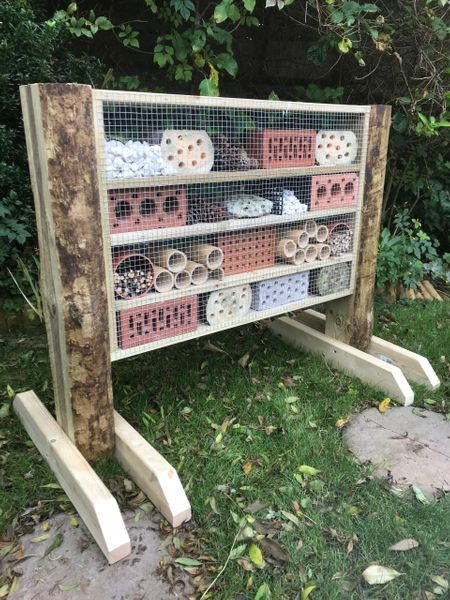How to (and why you should) build your very own bug hotel!

Bug hotels, wildlife stacks, insect houses, minibeast motels – these fun and fascinating nature projects go by many different names. As well as encouraging kids and adults to get creative outside, bug hotels are a great way to learn about local creepy crawlies. They also improve the biodiversity of your garden, helping plants and flowers to grow.
Read our guide on how – and why – to build your very own bug hotel and create an awesome wildlife feature for your home, school, nursery or daycare centre!
The benefits of building a bug hotel
Broadens your understanding of nature
A lot of kids grow up to be frightened of insects. They look weird, they skitter along the ground and parents are always in a rush to get rid of them. So it’s best just to avoid them, right?
Wrong! Bugs, beetles and insects play a very important role in growing and maintaining the world around us. They’re responsible for beautiful flowers, healthy vegetables and even making tasty foods (looking at you, bees).
By building a safe shelter for insects to lay their eggs and raise their young, bug hotels turn these creatures into an opportunity for educational outdoor play. This not only nips a lifelong fear in the bud, but also teaches kids about insect behaviours and life cycles. You can even help them learn more about their tiny guests through books, and make specific rooms in your hotel to accommodate certain species.
Teaching kids about the natural world through bug hotels lays an excellent foundation for environmental responsibility, active learning and even construction skills. As they grow older, these experiences will help them flourish into positive and capable adults.
Works wonders for your garden
Pollination is the key to growing beautiful flowers. But most pollinating insects don’t live in colonies. Instead, they tend to look for warm, dry areas to build their nests and hibernate in the winter.
That means your bug hotel is utterly irresistible to the insects that breathe life into your garden. As well as pollinating flowers, your residents can also eat the pests that chew through your favourite flora. You can even design a bug hotel specifically for bees to push back against the diminishing population.
But your bug hotel doesn’t just beautify your garden with flowers. The structure itself also stands out as an amazing and unique centrepiece!
Fights back against the loss of natural habitats
As we continue to cut down forests, hedges and flowers to make way for construction, the natural habits around us keep growing smaller. Your bug hotel offers the perfect refuge for tiny creatures who have lost their homes, and allows them to continue their work. This also helps children understand the effects we have on the natural world, and educates them about positive environmental practices.
Creates happy memories of childhood
The experiences we have as children play a big role in our physical, mental and emotional wellbeing as we age. These memories can prepare us to remain positive and confident even in later life.
Taking part in a new and exciting project like building a bug hotel can be a truly formative experience for a child. Collecting materials, completing a challenging task and sharing it with others also creates a powerful sense of achievement and curiosity. By involving kids in enjoyable community activities and creating wonderful childhood memories, we set them up for happiness and success.
It’s just great fun!
Probably the best reason to build a bug hotel is because it’s fun to do so! These hands-on projects bring people out into the fresh air and sunshine, and foster teamwork and learning among those who join in. That makes bug hotels perfect for schools, nurseries and daycares, and encourages kids to engage socially with the people around them.
How to build a bug hotel
1) Choose a good site
Some insects prefer cool, damp conditions. Others like to be in the sun. That means you’ll get different visitors depending on where you build your bug hotel.
If you want the widest variety of residents, try to put your hotel near an overgrown hedge or water feature, and slightly under a tree. This mix of environments will let you enjoy plenty of different species.
The best time to start your project is in autumn, when there are plenty of sticks and leaves for you to use. No matter where you decide to build, make sure the ground is flat and firm. Don’t put it too close to a vegetable patch, though, as your bugs might think their room includes a free buffet!
2) Build the basic structure
You’ll want to give your bug hotel a very strong framework so that it doesn’t collapse. Also, try not to make it taller than one metre, because the wind might knock it over.
Wooden pallets are the perfect building blocks for your project. They’re sturdy and already have plenty of gaps waiting to be filled.
Start by laying down bricks in the four corners of the structure. Then, place wooden pallets on top until your hotel has reached the right height. You can add more bricks underneath for support, but make sure to leave gaps in between for your many-legged guests to check in. You can also leave some large gaps to attract bigger wildlife like hedgehogs.
3) Prepare the rooms
When filling up your bug hotel, make sure to include plenty of nooks, crannies, tunnels and beds to attract a wide range of insects. Try to use as many natural materials as possible, but feel free to use cardboard where you need to.
Here’s a short list of some of the animals you can attract by using different materials:
- Beetles, centipedes, spiders and woodlice: dead wood and bark
- Ladybirds: dry leaves, sticks and straw
- Lacewings: corrugated cardboard
- Solitary bees: drilled wood, bamboo, reeds and small non-plastic tubes
- Frogs and toads: larger holes with stones and tiles
4) Add a roof
Once you’ve filled your bug hotel, it’ll need a roof to protect it from rain and birds. Top yours off with old roof tiles, slate, or planks of wood covered in roofing felt to create a pleasant atmosphere for the insects who come to stay.
It’s also a great idea to put some soil on top of your roof and add some wildflower seeds. These plants enjoy dry conditions, so they’ll still be able to take root all the way up there. When they grow, the flowers will attract bees, butterflies and other pollinating insects to your hotel.
5) The finishing touches
If you want to personalise your bug hotel, get creative with some decorations. You could paint the exposed wood, or even put up a sign with the name of your hotel on it. However you choose to decorate your bug hotel, remember to take a picture and share it on social media – and tag us so we can see!
6) Maintenance
The secret to a successful hotel is great customer service. And that’s also true for bug hotels.
Whenever you visit your new companions, make sure to clear out the spaces between the bricks so they can get in and out. Also, it’s a good idea to replace the straw, cardboard and leaves on a regular basis so that they don’t start to rot.
You might find that your bug hotel is a bit empty in the winter, when all the insects have gone into hibernation. But they’ll be back again as the weather gets warmer. So, plan ahead, and do a big spring clean before they arrive.
Can’t build your own bug hotel? Try one of ours!
Even if you know how to build a bug hotel, you might find you don’t have the time or materials to do it yourself. But that doesn’t mean you have to give up.
At Landscapes 4 Learning, we have plenty of outdoor educational play equipment, including amazing bug hotels that are perfect for homes, schools, nurseries and daycares. They arrive ready-made, so you and the kids can enjoy exciting educational play right away!
- Bug Hotel Globe: this mini hotel is just like the natural nesting place of solitary bees, ladybirds, beetles and other insects, so they’ll feel right at home. It’s packed full of beautiful flowers, and if you add some seed bombs it doubles as a bird feeder.
- Free Standing Rustic Bug Hotel: as a standard-sized bug hotel, this is a great choice for your first miniature menagerie. With plenty of rooms for all kinds of insects, you get all the benefits of a bug hotel in one convenient package.
- Grand Insect Hotel: our biggest, best and most diverse bug hotel features a huge range of rooms and facilities for all different kinds of insects. It’s full of hidey holes, nooks, crannies, arid plants and ivy, and even has a turfed roof and chimney.
Pick up one of our high-quality, affordable bug hotels today through our online shop, and bring fun, learning and life to your garden.
